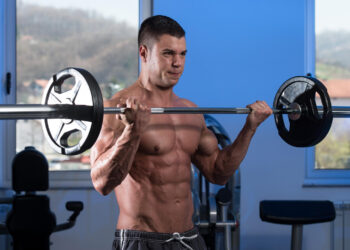Sled pushes are highly effective for developing explosive lower body strength. Research indicates that athletes who incorporate sled pushes into their training, regardless of the load, often experience greater speed improvements than those who engage in unresisted sprint training. (1)
Sled pushes are also an excellent exercise for the general population. This exercise improves overall conditioning, targets lower-body development, and increases functional strength. Let’s start with a simple guide showcasing how to perform sled pushes properly.
How To Do a Sled Push
Here is a step-by-step sled push guide:
Step One — Load the Sled
Load the sled with an appropriate weight. Start with a weight that reduces your sprint speed by about 25%. You can gradually increase the weight as you get better at the exercise.
Pro Tip: Start with a lighter weight and focus on proper form and technique. This will help prevent injury and ensure effective muscle and joint adaptation. Gradually increase the weight to ensure consistent strength and endurance gains.
Step Two — Assume the Starting Position
Grab the sled handles at roughly their center. Ensure your elbows are fully extended and locked out, your back is flat, your core and hip muscles are engaged, and you look forward. Raise your heels off the floor.
Level Up Your Fitness: Join our 💪 strong community in Fitness Volt Newsletter. Get daily inspiration, expert-backed workouts, nutrition tips, the latest in strength sports, and the support you need to reach your goals. Subscribe for free!
Pro Tip: Avoid placing your feet flat on the floor. Ensure that only the balls of your feet make contact with the ground to mimic the sprinting motion closely. While very heavy loads may necessitate placing your heels down, this technique offers limited benefits for improving sprint performance.
Step Three — Push the Sled
Drive the sled forward with explosive leg and hip power, maintaining a strong, stable core for maximum speed. Take short, quick steps to maintain momentum and maximize speed.
Push the sled for the desired distance, and then stop. If you have limited space, turn the sled and push it back to the starting point. Repeat this cycle for the desired distance.
Pro Tip: Brace your core muscles to create additional intra-abdominal pressure. Intra-abdominal pressure can help generate more force and ensure back safety.
Sled Push Muscles Worked
The primary muscles worked during sled pushes include the quadriceps, glutes, and calves.
The secondary muscles are the hamstrings, abs, obliques, deltoids, pectoral muscles, and triceps.
Benefits of the Sled Push Exercise
Here are the pros of sled push:
Basic Movement Pattern Reinforcement
Pushing an object is one of the most basic human movement patterns, alongside pulling, catching, throwing, climbing, walking, and jumping.
When you pick an exercise that closely mimics these patterns, you develop the most primal sense of strength and boost your functionality.
Great for Contrast Training
Contrast training involves pairing a heavy-weight exercise with a lighter-weight exercise to build explosive strength. For instance, alternate between heavy and light sled pushes.
There are several types of contrast training, and my personal favorite is the French contrast method.
Contrast training works because it leverages the post-activation potentiation effect (PAP), a phenomenon that occurs when a muscle’s force increases due to its previous contraction. (2)
Develops Functional Strength
Since sled pushes are a basic human movement pattern, they are excellent for developing functional strength, which is crucial for longevity.
For example, it is much more useful for seniors to be able to carry a bag of groceries or pick up their shoes from the ground than to perform 12 reps of machine preacher curls. This type of strength is only developed through exercising movements, not muscles.
Improved Speed
Pushing a sled, especially with heavier loads, has been shown to correlate nicely with speed development. However, as I already stated in the introduction of this article, this is primarily through explosive strength development.
Level Up Your Fitness: Join our 💪 strong community in Fitness Volt Newsletter. Get daily inspiration, expert-backed workouts, nutrition tips, the latest in strength sports, and the support you need to reach your goals. Subscribe for free!
Genetic factors highly predetermine speed as a motor ability and can only partially be changed. However, you can improve your speed by developing explosive strength, which is what sled pushes aim to do.
Great for People of All Fitness Levels
Pushing a sled carries little risk. Sled pushes are quite safe and beginner-friendly, unlike some other types of movements. This is why personal trainers widely consider sled pushes an entry-level exercise, and people of different fitness levels can perform them.
Expert Opinion on Cardio From Sled Pushing vs. Running
In a YouTube video, Sal Di Stefano, a certified personal trainer, discusses the difference between the cardio effects of sled pushes and running:
“They are totally different. Running is more of a steady-state activity; you are going to build endurance, and you are going to become more efficient at doing it. Sled pushing is more like strength training.”
Sled Push Alternatives
Here are the best sled push alternatives you must add to your arsenal:
Partner Band Sprints
Partner band sprints are another awesome exercise heavily used among sprinters and the athletic population for explosive strength development.
Steps:
- Wrap a resistance band around your waist and ask your training partner to hold it behind you.
- The resistance band should be taut in the starting position.
- Sprint straight as your partner provides light resistance for an added challenge.
Pro Tip: Instruct your partner to keep the resistance light. If the partner pulls too hard, it can hamper your sprinting technique.
Knees-Over-Toes Lunges
The knees-over-toes lunges will mimic the sled push motion while having a nice carryover to your running and sprinting performance.
Steps:
- Pick a dumbbell or kettlebell in each hand of appropriate weight.
- Assume a hip-width stance; ensure your back is straight and your head and neck are neutral.
- Lunge forward with your right leg, allowing your right knee to extend beyond your toes in the bottom position.
- Just before your left knee touches the ground, extend your knees and hips to bring your feet together.
- Lunge with your left leg and repeat the process for the desired reps.
Pro Tip: I highly recommend consulting a personal trainer before doing knee-over-toe lunges. If you’re new to these exercises, have past knee injuries, or aren’t in good shape, you risk injuring yourself.
Wall Pushes
This is a great sled push alternative you can perform just about anywhere.
Steps:
- Pick a sturdy wall.
- Place your hands flat against the wall at shoulder height and shoulder width apart.
- Take a few steps back from the wall so your body is at 45 degrees.
- Transfer your weight onto your toes as you lift your heels off the floor.
- Tighten your core muscles to stabilize your body.
- Lift one knee toward the wall while keeping the other leg straight and your foot firmly planted. Alternate legs at a steady pace.
- As you march, continuously push against the wall with your hands, engaging your chest, shoulders, and arms.
- Keep your back straight and your hips aligned with your shoulders and feet.
- Avoid sagging your lower back or lifting your hips.
- Perform the exercise for a set amount of time or number of marches per leg, focusing on maintaining steady, controlled movements.
Pro Tip: For an effective wall push, lean into the wall at a slight angle and focus on driving through your legs and core as if you are trying to move the wall. Keep your foot firm on the ground to maximize force transfer and prevent slipping, enhancing both stability and power output.
FAQs
Is the sled push effective?
The sled push is an excellent exercise for overall body conditioning, enhancing athletic performance, and building functional strength. It’s beginner-friendly and safe for all fitness levels, making it an effective workout option with a low risk of injury.
Are sled pushes better than squats?
You shouldn’t substitute squats for sled pushes. You can program both these exercises into a comprehensive lower-body workout. Nothing builds lower body strength and power better and more effectively than back squats.
Do sled pushes build muscle?
Sled pushing will definitely build a certain amount of muscle. However, they aren’t the best choice for lower-body muscle hypertrophy. Squat and deadlift variations will yield much better muscle-building results.
Wrapping Up
Sled pushes are highly effective for developing functional strength and improving sprinting speed. For the best results, I recommend that most gym-goers do sled pushes at least once every two weeks.
In the comments below, let me know your thoughts on sled pushes and how you implement them in your lower-body workouts.
References:
- Cahill MJ, Oliver JL, Cronin JB, Clark KP, Cross MR, Lloyd RS. Influence of resisted sled-push training on the sprint force-velocity profile of male high school athletes. Scand J Med Sci Sports. 2020;30(3):442-449. doi:10.1111/sms.13600
- Lorenz D. Postactivation potentiation: an introduction. Int J Sports Phys Ther. 2011;6(3):234-240.
Relevant Articles:
- How To Build Muscle And Strength With A Sled
- Strongman Robert Oberst Takes on Brutal 400-Lb Sled Workout
Interested in measuring your progress? Check out our strength standards for Preacher Curl, Deadlift, Squat, and more.








